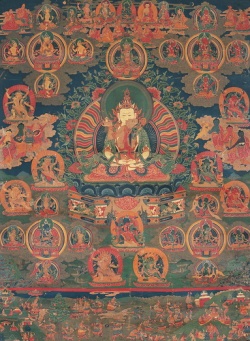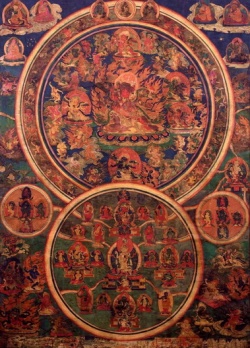Teachings on the Bardos given by H.H.Dudjom Rinpoch
First is the bardo of birth and life; second, the bardo of meditation;
third, the bardo of dreaming; fourth, the bardo of death and dying; fifth, the bardo of the true nature; and sixth, the bardo of becoming.
These six can be abridged to four: the bardo of birth
and life, the bardo of death and dying, the bardo of true nature,
and
the bardo of becoming. Of these four the bardo of birth and
life is most important because right now we all have a precious
human birth with the eighteen endowments.
We have available
to us teachers who are to a certain degree well qualified, and the
teaching we receive is a wish-fulfilling jewel, the very precious
teaching of the sutras and tantras. It is rare to have such a precious opportunity. Don’t waste your time when you have everything going for you.
First, you should contemplate the significance of the four
thoughts that can turn the mind from the futility of samsara. Train
your mind again and again by returning to that contemplation.
Combine this with a deep, heart-felt devotion to the three jewels
and the three roots, which are brought into one state in your root teacher who is the embodiment of three kinds of
kindness and
inseparable from Guru Padmasambhava. What is devotion? It is
having joy and appreciation for your opportunities, for the lama
and the dharma.
What are these four thoughts? First, think how difficult it is to
obtain the freedoms and endowments of the precious human
body. Second, consider how life and compounded things are
impermanent. Third, recognize the inexorability of karma,
of
results invariably following from causes. Fourth, observe that
none of the three realms of cyclic existence is beyond trouble and
suffering. The main point of this contemplation is to reduce
attachment and grasping to the activities of samsara.
Then begin the practices of the extraordinary ngondro.
Knowing the supreme qualities of the three jewels and thoroughly
understanding the difficulties of samsara, take refuge with clarity
and a profound aspiration to achieve the state of buddhahood
beyond samsara.
It is imperative to develop unshakable
bodhichitta to benefit all the limitless numbers of sentient beings
who have experienced uninterrupted difficulties throughout all their lifetimes. Develop unconditional love and compassion to
liberate all
beings from suffering. Again and again practice
“wishing bodhichitta” and “performing bodhichitta” according to
your capability, combining it with emptiness meditation.
To achieve the dharmakaya and the rupakaya enlightenment,
we must remove the two obscurations, and this can be
accomplished by accumulating both merit and wisdom. There are
many methods of accumulation, but one that is simple and brings
big results is the mandala offering practice. The means to instantly
destroy all faults,
downfalls, and obscurations is to meditate on
Vajrasattva, who is lord of all the families of deities, and to recite
the hundred-syllable mantra, the king of the secret mantras. To
remove obscurations and increase merit quickly,
the ultimate
essence of the vajrayana path is guru yoga combined with
meditation on shamatha and vipashana. Whoever follows these
practices is making their life more meaningful, and therefore, the
bardo of birth and life is more meaningful.
As I said, this bardo of birth and life is so very important. If
you can recognize this bardo as nothing more than a dream and a
magical display and combine that recognition with uncontrived
bodhichitta born from your heart, then you will master this bardo of birth and life. When you master the bardo of birth and life, you
will master all the other
bardos. And if you achieve that, you will
have become a great hero or heroine, not frightened by birth,
sickness, old age, and death. Then there will be no need for special
instructions concerning the bardo of death and dying.
However, to make sure the bardo of death and dying will be a
journey under your control, make sure right now you really
understand that the time of death is uncertain, the cause of death
is uncertain, and life is impermanent. Because compounded
things are not free from the four endings, they are impermanent. Therefore, the end of gathering is dissipation, the end of building
up is falling down, the end of birth is death, and the end coming
together is separating.
Therefore regard everything you see in
samsara as dreamlike. Your current circle of closest friends is as
fleeting as acquaintances bumping into each other at a fair. It’s all
one big magic show. It was like that in the past, it’s like that now,
and in the future it will be the same. Why be troubled by fear and
attachment? It won’t help.
Therefore, think, “I will never be afraid
or attached” and keep on thinking it as often as you can in this, your current life. Then make offerings of all your belongings,
including your body, to the buddhas and bodhisattvas of the ten directions, particularly to Amitabha.
Just as you would plan for a
trip, plan for your death, considering how and where you’ll go.
Your destination is Dewachen; your conveyance is togal, trekcho,
and phowa practice; your attitude, without any fear or sadness, is
joyful and confident. Now, when you possess vitality and all your
faculties, is the time to practice generosity, giving as much as you
can to others, thereby accumulating merit.
If you can’t do this
now, how will you do it when death is near? You’ll be sick and
your mind scattered. Your feelings of attachment to and worry
about your life, loved ones, and possessions will be even more
intense when you have no
alternative but to leave everything as it
currently stands. To avoid that eventuality, prepare now, perform
virtuous activities, ensure that you have no fears and regrets.
Now
we all have the great fortune to receive these clear light, Dzogchen
teachings, and if you practice them with joyful effort and
commitment, you can in this very lifetime achieve the level of a
vidyadhara. If that level is not attained, then at the very least your
mind will be clear, stable, and relaxed at the time of death.
Rehearse your lama’s instructions once more like an actress
glancing at herself in the mirror just before going on stage, then
die with a smile of joy and confidence. With courage born of an
unshakable view allow the dissolving stages to gradually occur,
and you will have the fortunate opportunity to be liberated in the
dharmakaya or the sambhogakaya. Thus, he thoroughly presented the teachings.
From LIGHT OF FEARLESS INDESTRUCTIBLE WISDOM: The Life and Legacy of His Holiness Dudjom Rinpoche


